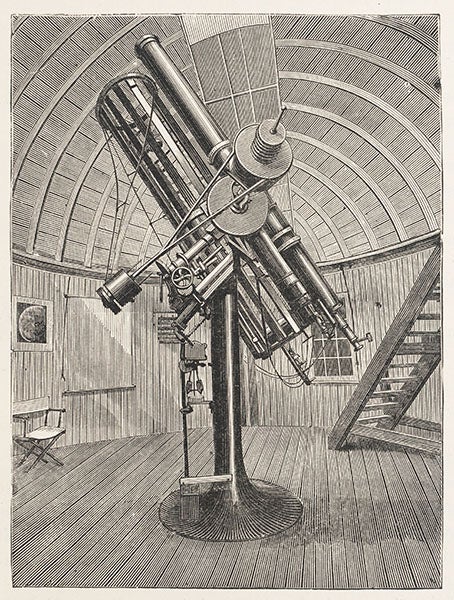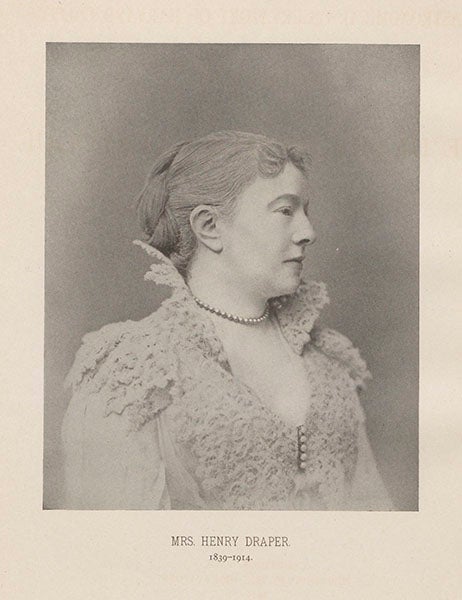How Much Money Did Anna Draper Give Harvard
Built-in to wealth and privilege on September nineteen, 1839, Mary Anna Palmer grew up in a New York Metropolis mansion on Madison Artery. Later she dropped her get-go proper name and turned her babyhood home into a combination laboratory and workshop for her hubby, the medical doc, pharmacist, and renowned amateur astronomer Henry Draper. The three-story residence too served the couple as a scientific salon – a venue for entertaining their colleagues in the National University of Sciences, for hosting lectures on new discoveries to large audiences, and for mounting handsome exhibits of astrophotography.
The Drapers began living their commitment to astronomy every bit newlyweds in the autumn of 1867. Their honeymoon took them only as far equally lower Manhattan, to purchase a glass blank, 28 inches in diameter, which they polished and rouged and coated with silver to style the mirror of a big reflector telescope. At their country observatory in Hastings-on-Hudson, they used this musical instrument to take the first-always photograph of the spectrum of a star, Vega, in 1872.

Henry Draper'south 28-inch reflector, the lens for which was purchased by Henry and Anna on their honeymoon. It is mounted along with a 12-inch Clark refractor that was purchased soon after. Both of these instruments were donated to Harvard College Observatory by Mrs. Draper; from Washington Astronomical Observations, 1876 (Linda Hall Library)
Over a period of xv years, Henry and Anna Palmer Draper formed an observational partnership on a par with that of their friends-cum-rivals in England, Sir William and Lady Margaret Huggins. Just in 1882, but when the Drapers had organized their affairs to devote themselves full-time to photographing and classifying the spectra of the stars, Henry died suddenly of pneumonia at historic period forty-five.

Mary Anna Palmer Draper (seated near center) with the women computers at Harvard College Observatory. The adult female immediately behind Mrs. Draper is Antonia Maury; just to the right is Williamina Fleming (Harvard College Observatory, courtesy of Tom Fine)
The widow hoped to deport on their planned research with the aid of one or two hired assistants. When this proved too daunting, nonetheless, she agreed to permit her friend Edward Pickering of the Harvard College Observatory take over the project. She gave all of Henry's images and notebooks to Pickering, and donated his telescopes also, paying to take them transported, refurbished, and housed in proper domes. Mayhap virtually importantly, she channeled the railroad-and-real-estate fortune she had inherited from her male parent, Cortlandt Palmer, to the work at Harvard, which she insisted on naming the Henry Draper Memorial. She followed its progress closely through a steady correspondence with the director. Though they wrote to each other several times a calendar week over the side by side xxx years, they never strayed from polite forms of address: "My dearest Professor Pickering," her messages all began, and he replied in kind to "My dear Mrs. Draper."

Observatory Hill at Harvard, plough of the century, postcard. Three of the buildings in the foreground were erected at Mrs. Draper'due south expense, in order to firm Henry Draper'due south telescopes, which she gave to the College as function of the Draper Memorial. (Harvard Higher Observatory, courtesy of Tom Fine)
In her regular visits to the observatory, she befriended Annie Jump Cannon and Williamina Fleming, two of the women employed at the observatory to clarify the glass photographic plates, and who carried out the piece of work of creating a stellar classification organisation that remains in use today. Anna's closeness with Pickering and his wife, Lizzie Wadsworth Sparks, encouraged the 3 friends to travel together – to Colorado Springs, for example, to test Pikes Pinnacle'due south suitability equally a high-altitude observatory site, and to Washington, Georgia, to see the full solar eclipse of May 28, 1900. (Though this was Anna'south second solar eclipse expedition, it provided her first view of totality. When she accompanied Henry to the Wyoming Territory for the eclipse of July 29, 1878, she had voluntarily sequestered herself inside a tent, and then as to correctly count and call out the seconds of totality for the observers, with no danger of becoming distracted by the spectacle.)

First volume of the nine-volume Henry Draper Catalogue of stellar spectra; the frontispiece shows vii typical spectra, from spectral type O downwards to M, Annals of the Astronomical Observatory of Harvard Higher, volume 91, 1918 (Linda Hall Library)
By the time of her expiry, on December eight, 1914, Anna Draper had invested a quarter of a million dollars in her husband's dream. In her will she gifted an additional $150,000 for the ongoing intendance and study of the several hundred thousand photographic plates, which are still preserved at the Harvard Observatory.

Mary Anna Palmer Draper, portrait frontispiece, Annals of the Astronomical Observatory of Harvard College, volume 93, 1919 (Linda Hall Library)
The published results of the Henry Draper Catalogue of Stellar Spectra fill up nine volumes of the Register of the Astronomical Observatory at Harvard College (fifth image). "The Henry Draper Memorial is due to the unfailing devotion of Mrs. Draper to the memory of her husband," Pickering wrote in December 1918, in a cursory preface to volume iii, in which her portrait appears as the frontispiece (sixth image). Her devotion and largesse also inspired her to create the Henry Draper gold medal, all the same awarded today by the National Academy of Sciences for outstanding original contributions to astrophysics.
Dava Sobel is the writer of Longitude, Galileo'due south Daughter, and, virtually recently, The Drinking glass Universe, in which Mrs. Draper plays a major role.
Source: https://www.lindahall.org/about/news/scientist-of-the-day/mary-anna-palmer-draper
Posted by: cartercastand.blogspot.com

0 Response to "How Much Money Did Anna Draper Give Harvard"
Post a Comment